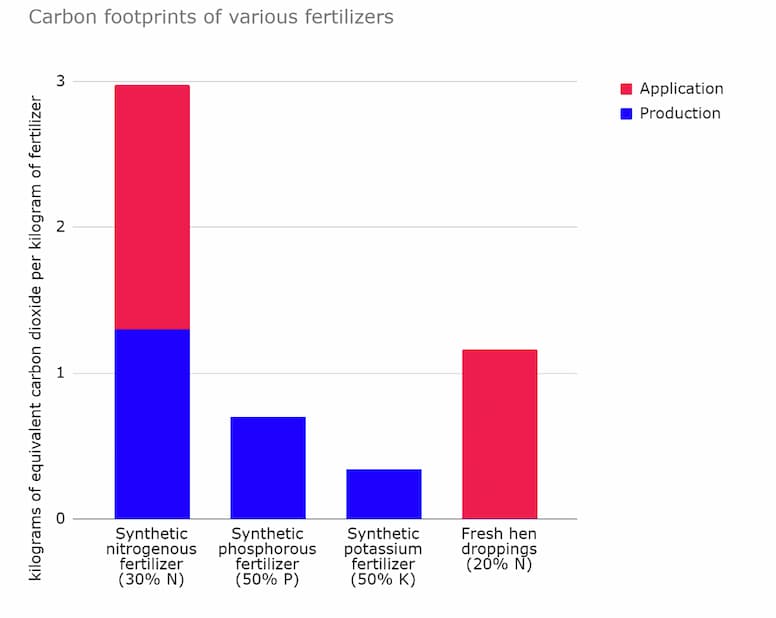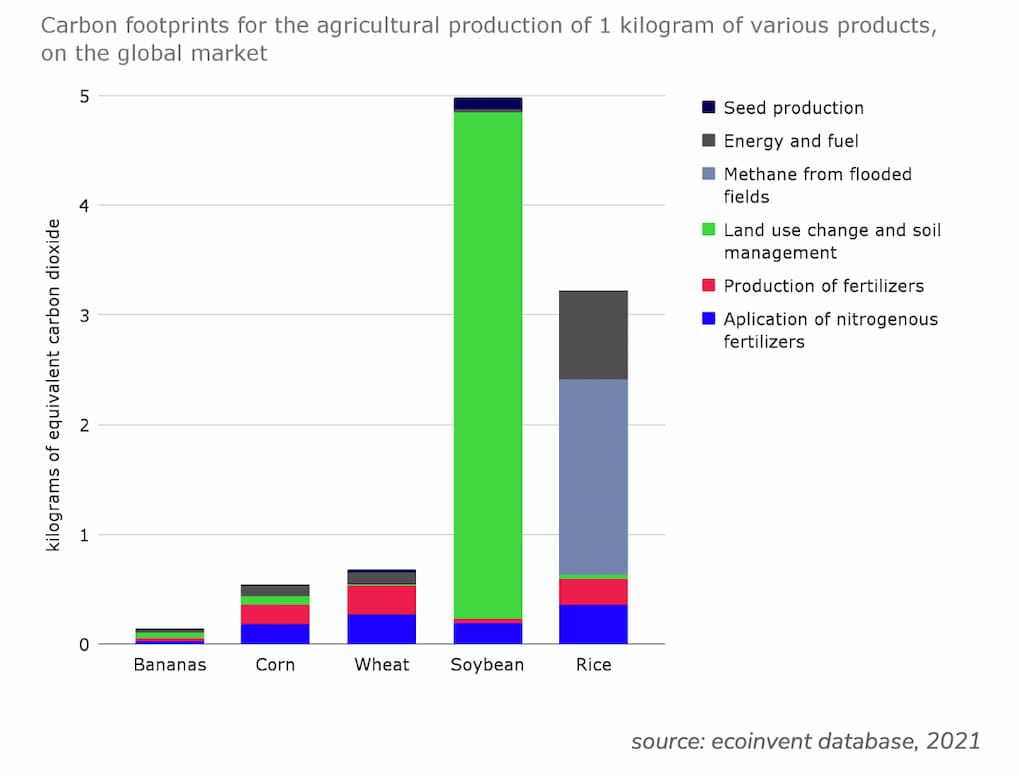Popular belief is that cereal grains, legumes, and especially produce should be chosen organic and produced as locally as possible. And, for once, this is somewhat true! Let us decompose the carbon footprint of plant agriculture and figure out what you should look out for when choosing your plant products.
There are many sources of carbon emissions in the life cycle of plant products, from the production of agricultural inputs to the food on our plates. We tend to focus on transport and packaging because they are the most visible and the ones we can directly control, but they are in fact very minor compared to other sources. If you want to know the biggest emission sources, here are the real impacting emissions sources.
1. Land use change can be a major climate issue in countries with deforestation and dense vegetation
How does the carbon cycle of soil work? If you plant a tree, it will grow by taking carbon from the soil and the air and storing it within its organic matter. As long as the tree lives, it is a carbon sink.
If the tree dies, it will decompose and transfer its carbon back to the soil and the atmosphere.
If you cut down the tree and make an object out of it, the carbon will be stored in this object for its lifespan, and then eventually be burned or decomposed.
The takeaway is that the only way to store carbon is to plant definitive forests – where trees will be replaced, either artificially when cut or naturally when they die. When we cut down a forest to make space for cropland or pasture, we release stored carbon into the soil and the atmosphere. This is why land use change must be accounted for when calculating the impact of products on the climate.
Land use change emissions are the amount of greenhouse gasses freed into the atmosphere by converting one hectare of natural land into agricultural land. The denser and richer the vegetation on the natural land, the higher the carbon cost of turning it into pasture or cropland. This is why we often hear about the impact of agriculture in Brazil: this is a country where agricultural land is currently expanding and the natural land is very rich. India, on the other hand, has rich forests, but its agricultural land is not currently in expansion, so on average, a product coming from India will not have been responsible for any deforestation.
The countries where land use change emissions per hectare are the highest are Indonesia, Brazil, Argentina, and other South American, Central African, and Asian countries in the equatorial and tropical regions with dense forests. So when you purchase any product, it is preferable to avoid these countries or look for guarantees that the product did not lead to any deforestation.
2. Soil management: tillage and draining release soil carbon stocks
Soil management designates all agricultural actions on soils, from tilling for sowing to fertilizing crops. Fertilizers and pesticides will be dealt with in the following paragraphs. Tillage is the action of turning over the soil to increase aeration, and drainage is the removal of excess water using ditches or pipes.
These actions impact soil microorganisms’ activity – which influences carbon dioxide emissions -, as well as nitrification and denitrification processes – which regulate emissions of nitrous oxide, a greenhouse gas -, and decomposition of soil organic matter – which causes emissions of methane, another greenhouse gas.
The majority of emissions from managed soils come from nitrous oxide emissions. The exact emissions caused by different management practices on different soils are not very well known, but the ADEME suggests a generic factor for France of 3.445 tons of CO2e per hectare of managed land.
Methane emissions from organic matter decomposition in flooded rice fields are very important.
The case of rice fields is unique, as these crops are flooded for long periods of time. Because of this, organic materials that are in and on the ground (plant and animal remain, hummus…) decompose anaerobically, which produces excessive amounts of methane that end up in the atmosphere. This effect depends on the flooding regime of the field, prior to and during the cultivating season, the soil type, and the variety of rice cultivated. This source is major for rice production, representing 40 to 50% of its carbon footprint!
3. Pesticides emit greenhouse gasses through their production
Pesticides are chemical or biological agents applied to crops to drive away pests. They can be classified by target: herbicides are the most used and represent 80% of global consumption of pesticides. Insecticides and fungicides are also common, but others exist such as bactericides, rodenticides, etc.
In terms of carbon, however, pesticide emissions come from energy and materials used during production, packaging, and transport. They are therefore not very emissive. Nevertheless, pesticides are a major risk for water and biodiversity: since 95% of herbicides and 98% of sprayed insecticides reach destinations other than their target species, such as pollinators or water bodies.
4. Fertilizers and amendments are huge sources of greenhouse gasses, because of their production and their application onto soils
Fertilizers are synthetic or organic products containing nutrients necessary for plant growth. They are applied to agricultural soils to help crops develop and are essential to achieve sufficient yields. Fertilizers contain three main macronutrients, which are needed in specific ratios: nitrogen (N), phosphorus (P), and potassium (K).
Synthetic fertilizers: the baseline villains.
Synthetic fertilizers can be simple if they contain only one macronutrient, binary if they contain two, or “NPK” when they contain all three macronutrients. The nitrogen in synthetic fertilizers is in the form of ammonia, which is obtained through industrial processes that use natural gas or petroleum coke as a source of hydrogen and air as a source of nitrogen. These processes are energy-intensive and use fossil fuels or their derivatives as raw materials, which makes them very carbon-intensive. Phosphate for fertilizer use is produced by the treatment of extracted phosphate rock, while the potassium used for synthetic fertilizers is a purified mixture of potassium minerals. These processes emit greenhouse gasses, but not nearly as much as nitrogenous fertilizers.
On top of these carbon emissions from production, nitrogenous fertilizers emit nitrous oxide – a greenhouse gas – once they are spread onto fields and converted by soil bacteria. Spreading one kilogram of nitrogen, in any synthetic fertilizer, will emit 5.6 kilograms of CO2e. This is even more than the carbon cost of producing nitrogenous fertilizers (4.3 kilograms of CO2e emitted to produce one kilogram of nitrogen for an average nitrogenous fertilizer)! This confirms nitrogenous fertilizers as the most destructive type of fertilizer for the climate.
Organic fertilizers: a better solution.
“Organic fertilizer” is an ambiguous term. It can designate naturally produced fertilizing materials – such as animal manure, compost, or raw harvested minerals -, but also fertilizing products that comply with organic agriculture norms. The latter are usually made from natural materials with the addition of minerals. In both cases, organic fertilizers are less concentrated in nutrients than synthetic ones and are applied in larger quantities.
The production of such fertilizers is less carbon-intensive than synthetic fertilizers. But as organic fertilizers also contain nitrogen, spreading them onto soil will also emit nitrous oxide: the emissions after spreading these fertilizers are similar to synthetic fertilizer, for equal amounts of pure nitrogen. Overall, thanks to their low production emissions, organic fertilizers are still less carbon intensive than synthetic ones, which makes organic agriculture a good choice for plant products.
It must also be noted that, on top of the impact of fertilizers on the climate, these products often seep into water bodies, causing health hazards and damage to biodiversity. Examples of this are the eutrophication of lakes and ocean dead zones.

The takeaway: why should we eat local and organic produce?
What are the main sources of carbon emissions from plant agriculture? Nitrogenous fertilizers are a major and universal source, land use change can play a huge role but only in some countries, and the energy and fuels used for agriculture are an incompressible and important cause of carbon emissions.
By choosing products from organic agriculture, one can reduce the emissions from fertilizer production. Products coming from countries with as little deforestation as possible are also the best climate-conscious choice. If possible, choose them from your region, as this will also reduce the carbon cost of their transportation – a minor source, but one that can be easily reduced and plays a part in the footprint of products.

If you’re interested in assessing the carbon footprint of your business, do not hesitate to contact us. At Carbometrix, we realize full scopes carbon footprints in a light touch and very fast way.
